Charles Brady King
| Charles Brady King | |
|---|---|
|
c. 1915 | |
| Born |
February 2, 1868 Angel Island, California |
| Died |
June 22, 1957 (aged 89) Rye, New York[1] |
| Occupation | engineer / inventor |
| Spouse(s) | Grace Fletcher |
| Signature | |
 | |
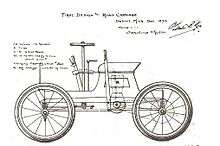

Charles Brady King is on the right.
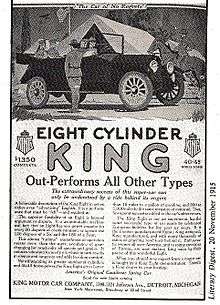


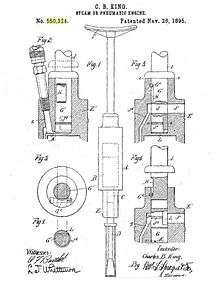
Charles Brady King (February 2, 1868 – June 22, 1957) was an American engineer and entrepreneur remembered as an automotive pioneer, artist, etcher, musician, poet, architect, mystic, industrialist and inventor.[2][3][4][5]
King was the first person in Detroit to design, build and drive a self-propelled automobile[5][6][7] – 3 months before Henry Ford built his automobile.[8] The Detroit Journal of March 7, 1896, reports that King drove his motor-powered vehicle down Woodward Avenue – being the first person in Detroit to build and drive such a vehicle.[9] The Journal also reports King made and sold the first complete automobile in Detroit.[9]
Early life
King was born February 2, 1868, at Camp Reynolds on Angel Island, California.[4][10] His father was a Civil War Union Army general, General John Haskell King.[2][5] His mother was Matilda C. Davenport, from the New England family line of Davenports that settled in Detroit.[4][5]
Career
King was first sent to Trinity College in Port Hope (Ontario) for two years, then went to Cascadilla School in Ithaca, New York, for preparation for entrance to Cornell University.[5] Then in 1887 he entered Cornell (engineering class of 1891), but was only there for two years.[4] He moved to Detroit around 1888 or 1889 at the age of 20, shortly after his father's death. His first full-time job was as a draftsman at Michigan Car Company in Detroit.[4][5]
First car made by King
King started designing and building his first car from the time of the Chicago World's Fair of 1893. He test drove his first car in Detroit in front of hundreds of spectators on March 6, 1896, at speeds up to seven miles per hour. It was powered by a Sintz engine. The time was just before 11 P.M. The route that King did started from a building on St. Antoine Street, going first south toward the Detroit River. When he arrived at Jefferson Avenue he turned right. After passing by several businesses he arrived at Woodward Avenue. He turned right again onto that street. He again passed by several businesses and then stopped for a short time at Cadillac Square at the Russell House hotel. Henry Ford was present when King demonstrated his horseless carriage, riding a bicycle behind![4][11][12][13]
King showed to the Detroit public his car, which probably was the first in Michigan, however not the first in the world nor even the first in the United States.[4] King served as a mentor to Henry Ford, Ransom E. Olds and others for their inspiration to develop a "horseless carriage". Their gasoline powered automobiles came out months later.[3][4] He did secret road tests in 1895, prior to this public display.[14]
The Detroit Journal interviewed King and there he said what the journal considers his most famous quote
| “ |
I am convinced they [horseless carriages] will in time supersede the horse.[15] |
” |
The Detroit Free Press newspaper wrote up an article the next morning saying
| “ |
The first horseless carriage seen in this city was out on the streets last night. It is the invention of Charles B. King, a Detroiter, and its progress up down Woodward Avenue about 11 o’clock caused a deal of comment, people crowding around it so that its progress was impeded. The apparatus seemed to work all right, and went at the rate of five or six miles an hour at an even rate of speed.[3] |
” |
King had the intention of running his motocycle in America's first automobile race of 1895, however his car wasn't quite ready for the race as were many others that also dropped out.[16]
Other cars
King joined the Olds Motor Works around 1900, but resigned after their plant burned down.[17] He then joined the Northern Manufacturing Company in 1902 and in 1903 became their chief engineer until 1908. One well known car he designed was the two-cylinder "Silent Northern" – the automobile with the first integrated motor and transmission assembly and the first side-step running boards. The 1907 Northern car model also had three-point engine suspension, air brakes, an air-controlled clutch and other innovations new to the auto industry of the time.[4]
King went to Europe for two years to study automotive design in 1908. When he came back in 1910 he started the King Motor Car Company with the knowledge he acquired. He was the first automaker to make cars with left-hand steering. He also was the first to successfully make a practical working V-8 engine. The King automobile called "the Eight" was advertised as "The Car of No Regrets." The King automobile was the only vehicle to feature left-hand steering at the 1912 New York Auto Show. He left the King Automobile company in 1912, however held full possession of his patents. The King name for the car company continued for many years thereafter and produced up to 1000 automobiles under this name. The company was ultimately absorbed by the Studebaker Car Company.[4][18]
King was a founding member of the Automobile Old Timers in 1939, the original name of what was to become the Automotive Hall of Fame. King was an umpire in America's first automobile race as well as a participant.[4]
Other interests
King visited the World's Columbian Exposition in Chicago in 1893 to display two of his new inventions, a pneumatic hammer and a brake beam for railroad cars. By 1893 King worked for the Russel Wheel and Foundry Company and at the Exposition was put in charge of their exhibit in the Transportation Building, which he considered a great opportunity to learn about the latest engineering feats and exhibit his new inventions.[5] His pneumatic hammer invention (for riveting and caulking) was unique, being the only tool of its kind there, and earned him the Exposition highest award of a special diploma certificate and a bronze medal.[4][5][9]
King saw Gottlieb Daimler’s self-propelled carriage at the Exposition. He also learned about this same time that the Duryea Brothers had built and tested a self-propelled carriage. He then went about the quest of designing his own "horseless carriage".[3]
King provided parts, instructions and assistance to Henry Ford for his first horseless carriage.[3] He gave Ford two valves from one of his engines during retrofitting so that Ford could build his first car, the Quadricycle.[4][19]
King designed and assisted in building a 70-foot yacht called the Lady Frances that was sold to an Eastern buyer. It had many new innovations for gasoline motors, including a self-starting device. He formed with others the Michigan Yacht and Power Company.[20]
The American Motor League was organized by King[21] and he was issued the first membership number issued each year, No. 100.[22]
Inventions
King is considered the inventor of the jackhammer.[23] He not only invented the jackhammer,[24] but several other machines, tools, mechanisms, attachments and sundry devices.[25] Below are just some of his 64 inventions that ultimately made him independently wealthy.[5]
-

Railcar brake beam, 1894
Patent 513,942 -

Sparking Mechanism
Patent 739,882 -

Transmission 1904
Patent 869,494 -
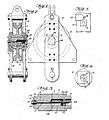
Lubricated pulley
Patent 786790 -

Steam shovel, 1905
Patent 786,448 -

Steam shovel apparatus
Patent 760456 -
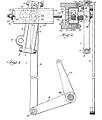
Valve-Gear, 1905
Patent 799,169 -

Steering Mechanism, 1906
Patent 830,721 -
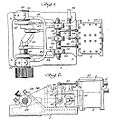
Reversible Steam Engine Patent 842,465 -

Transmission, 1907
Patent 857,002 -

Transmission, 1908
Patent 890,565 -

Steam shovel boom
Patent 1,012,087 -

Car steering gear
Patent 1,012,562 -

Ballast-Unloader
Patent 1,043,844 -

Spring Suspension
Patent 1,209,716
References
- ↑ Charles Brady King tombstone
- 1 2 "King Motor Car Club of America". Clubs.hemmings.com. Archived from the original on 2011-09-27. Retrieved 2011-05-19.
- 1 2 3 4 5 "Inductees". Automotivehalloffame.org. Retrieved 2011-05-19.
- 1 2 3 4 5 6 7 8 9 10 11 12 13 Powell, pp. 6-9
- 1 2 3 4 5 6 7 8 9 May, George S., Encyclopedia..., pp. 286-293
- ↑ Reive, Steven (2009-02-27). "Charles B. King pioneered horseless carriages. Henry Ford was a mere tot when King tested his car in Detroit". wordpress.com weblog. Retrieved 2013-09-02.
- ↑ May, p. 16
- ↑ "The River that changed the World". Motorcities.org. Retrieved 2013-09-19.
- 1 2 3 Lewis, p. 171
- ↑ King, p. 13
- ↑ Olson, p. 72-73
- ↑ Woodford, p. 89
- ↑ Hillstrom, p. 62
- ↑ May, A most unique machine..., pp. 15-25
- ↑ Detroit Journal article, 7 March 1896
- ↑ The Chicago Times-Herald newspaper clipping of November 29, 1895
- ↑ Lewis, p. 140
- ↑ Lewis, p. 173
- ↑ King, p. 44
- ↑ Lewis, p. 172
- ↑ "American Motor League organized by King on November 28, 1895". Clubs.hemmings.com. Archived from the original on 2011-09-27. Retrieved 2011-05-19.
- ↑ King, pp. 41-43
- ↑ Charles Brady King inventor of jackhammer is born
- ↑ "Patent 550,324". Google.com. Retrieved 2011-05-19.
- ↑ "Brake Beam patent". Google.com. Retrieved 2011-05-19.
Primary Sources
- Detroit Public Library, Automotive History Collection - "King Papers"
- Detroit Public Library, Burton Historical Collection - "King Papers"
- Cornell University Library, Archives Division -"Charles King Papers"
- Henry Ford Museum, The Ford Archives - "Charles Brady King items"
- King, Charles B., A Golden Anniversary 1895-1945 / Personal Side Lights of America's First Automobile Race, Privately Printed, 1945
Secondary Sources
- Hillstrom, Kevin, The industrial revolution in America: automobiles, ABC-CLIO, 2006, ISBN 1-85109-749-X
- Lewis, Eugene w., Motor Memories, A Saga of Whirling Gears, Alved Publishers, 1947
- May, George S., A most unique machine: the Michigan origins of the American automobile industry, Eerdmans, 1975
- May, George S., Encyclopedia of American Business History and Biography, Bruccoli Clark Layman, 1990, ISBN 0-8160-2084-1
- Olson, Sidney, Young Henry Ford: a picture history of the first forty years , Wayne State University Press, 1963, ISBN 0-8143-1224-1
- Powell, Sinclair, Michigan History magazine, Michigan Department of State, November 1985, vol 69, Issue 6, ISSN 0026-2196
- Woodford, Arthur M., This is Detroit, 1701-2001 , Wayne State University Press, 2001, ISBN 0-8143-2914-4
